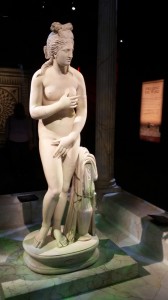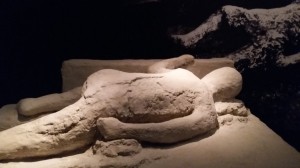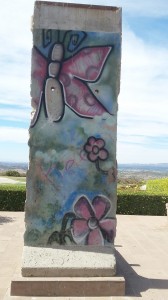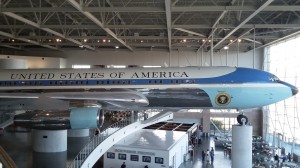THE REAGAN LIBRARY
THE REAGAN LIBRARY
By Charles N. Stevens
Photos by Dolores Seidman
As our bus winds up the hill toward the Reagan Library, I think about the song, “High on a Windy Hill,” a hit of the 40s. After many turns, we finally arrive at the top, the Reagan Library spread out before us. It truly is high on a windy hill, the view of the Simi Valley and the hills that enclose it, magnificent. I also think of the lines from Reagan’s acceptance speech when he proclaimed that America would be a “shining city on a hill.” His library seems symbolic of that.
We first enter a vast patio area edged in trees, a fountain splashing in its center. It is a very pleasant way to enter the library. We are, of course, interested in what the library offers about Ronald Reagan, but presently there is an extensive display of artifacts from Pompeii, the city buried by the eruption of Mt. Vesuvius in 79 AD. Since this is a traveling exhibit and won’t be here long, this is our choice for the day.
We began our tour of the exhibition in dimly lighted rooms that protect the artifacts, first looking at the two-thousand year old statues of Roman men, exquisite in every detail. Most interesting was the statue of Aphrodite, goddess of love. She was nude with neither towels nor cloaks draped over her arm, as though she were either going into her bath or was emerging from it. We gazed at pottery, including the large amphora used to store or transport wine or olive oil. A glass bowl looked as though in had been made in modern times, a tribute to their working with glass that long ago. There were also exhibits of more mundane objects like kitchen implements and pipes and valves to control water flow. The most touching exhibits were the casts of human beings (these were replicas) caught in the ash flow from the volcano, many in the act of shielding themselves from the rain of ashes and cinders. It was truly sad to see them. It made me think of what I would do in such a calamity. Rounding out the exhibit was a special room where we experienced that day of the eruption with roaring and shaking, jets of steam and visual effects.
By the end of the exhibition we were hungry. We found our way to Reagan’s Country Café where we ordered pulled pork sandwiches. We took them to the outdoor seating lounge where we could eat and look out over the Simi Valley. What a pleasant experience!
Afterwards we walked out on a terrace to an actual section of the Berlin Wall. This was especially important to Reagan after his Berlin speech in which he said, “Mr. Gorbachev. Tear down this wall!” Soon after the speech, the wall was removed. We continued across the grounds to the memorial site where Reagan and his wife, Nancy, are buried. A gentle wind rustles the trees and extends the flags.
Next, we’re on our way to the huge “hangar” where the presidential plane, Air Force One, is displayed. We were first amazed at how huge the Air Force One Pavilion and the plane itself was. There are 40,000 square feet in the pavilion. The plane is a Boeing 707 that Reagan used for his official flights. The plane was also used by presidents Nixon, Ford, Carter, both Bushes and Clinton. The plane was flown to San Bernardino International Airport then disassembled by the Boeing Company. From here, it was brought piece by piece and reassembled at its present home in the Reagan Library. We entered the plane just behind the pilot’s compartment, walked through it, noting all the compartments used by the president and staff as well as the press. It was quite a feeling, walking and being where presidents worked. All is quiet inside now, but we can imagine the scene inside when the plane was on its way to London or Berlin, the activity that must have taken place. We exited the aircraft near the tail. The pavilion also includes Marine One, the helicopter that transported the presidents on the short hops to the airport or Camp David.
Our visit was drawing to a close, but we did have time to see a presentation about Ronald Reagan which near its end showed a 3D hologram of the president and his dog with his actual voice. It was amazing how real it seemed, as though he had risen from the dead.
We will have to return at a future date to see all we missed.

One of the highlights of the Pompeii exhibit is this statue of Venus leaving her bath.

This is the cast of a man felled and covered with ash on that fateful night of the eruption of Vesuvius
.

Reagan was instrumental in the tearing down of the Berlin Wall a section pictured here.

Most amazing is Air Force One, the presidential plane in its gigantic hangar.
MONTEREY PARK AUTHOR PUBLISHES 4th BOOK – Seeking More of the Sky: Growing Up in the 1930’s:
Charles “Norm” Stevens, a 43 year resident of Monterey Park has recently published his 4th book: Seeking More of the Sky: Growing Up in the 1930’s. This is the story of a young boy growing up in Inglewood, California in the l930’s. This was a time during the depression when unemployment was affecting many and the banks were closed, while the clouds of war were gathering in Europe. But he was lucky enough to be raised in a loving family, the power of that love reflected throughout his stories.
Stevens is the author of three previous books about his experiences during WWII:
An Innocent at Polebrook: A Memoir of an 8th Air Force Bombardier (Story of his 34 bombing missions from his base at Polebrook, England over Germany and France)
The Innocent Cadet: Becoming A World War II Bombardier (A prequel to the first, telling of his training in the U.S. before going overseas into combat.)
Back from Combat: A WWII Bombardier Faces His Military Future from Combat: (This book details the time from when he returned from combat in England until the end of the war.)
He is known to the readers of The Citizen’s Voice as the author of Travel Log Articles including “Cruising the Rhine and Mosel”,” Best of the West”, “In Search of Snow” , “From Paris to Normandy on the Seine”, and “Exploring New York”. He is retired, having taught for 32 years, primarily in the Montebello Unified School District.
Those interested in purchasing an autographed copy of any of his books, may contact the author at 323-721-8230 or Normstevens24@gmail.com.



